Unit10 I'd like some noodles说课稿
- 格式:docx
- 大小:14.17 KB
- 文档页数:6
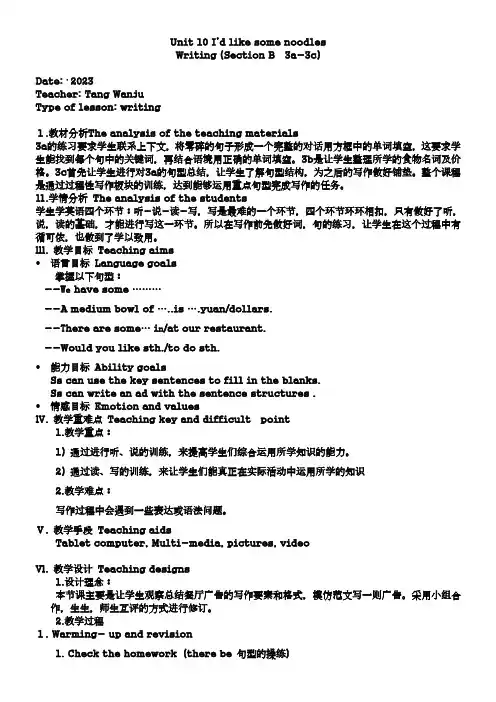
Unit 10 I’d like some noodlesWriting (Section B 3a-3c)Date: . 2023Teacher: Tang WanjuType of lesson: writingⅠ.教材分析The analysis of the teaching materials3a的练习要求学生联系上下文,将零碎的句子形成一个完整的对话用方框中的单词填空,这要求学生能找到每个句中的关键词,再结合语境用正确的单词填空。
3b是让学生整理所学的食物名词及价格。
3c首先让学生进行对3a的句型总结,让学生了解句型结构,为之后的写作做好铺垫。
整个课程是通过过程性写作板块的训练,达到能够运用重点句型完成写作的任务。
Ⅱ.学情分析The analysis of the students学生学英语四个环节:听-说-读-写,写是最难的一个环节,四个环节环环相扣,只有做好了听,说,读的基础,才能进行写这一环节。
所以在写作前先做好词,句的练习,让学生在这个过程中有循可依,也做到了学以致用。
Ⅲ. 教学目标Teaching aims•语言目标Language goals掌握以下句型:--We have some ………--A medium bowl of …..is ….yuan/dollars.--T here are some… i n/at our restaurant.--Would you like sth./to do sth.•能力目标Ability goalsSs can use the key sentences to fill in the blanks.Ss can write an ad with the sentence structures .•情感目标Emotion and valuesⅣ. 教学重难点Teaching key and difficult point1.教学重点:1) 通过进行听、说的训练,来提高学生们综合运用所学知识的能力。
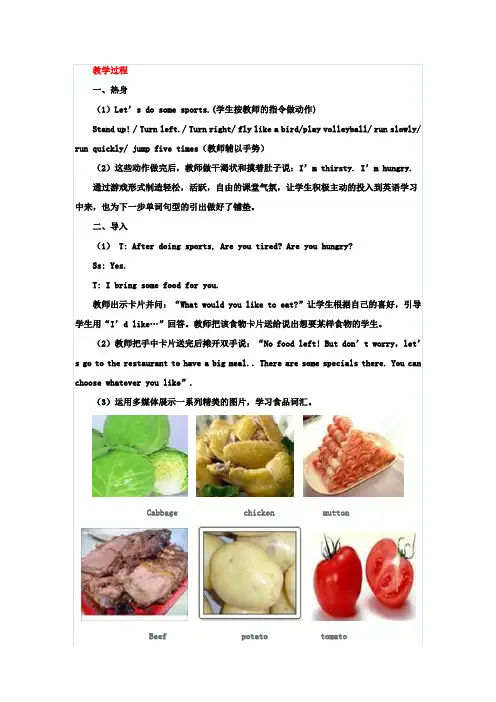
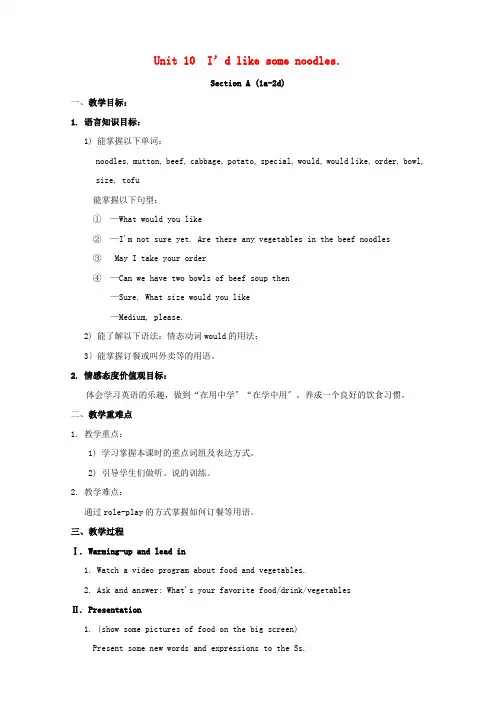
Unit 10 I’d like some noodles.Section A (1a-2d)一、教学目标:1. 语言知识目标:1) 能掌握以下单词:noodles, mutton, beef, cabbage, potato, special, would, would like, order, bowl, size, tofu能掌握以下句型:①—What would you like②—I'm not sure yet. Are there any vegetables in the beef noodles③ May I take your order④—Can we have two bowls of beef soup then—Sure. What size would you like—Medium, please.2) 能了解以下语法:情态动词would的用法;3〕能掌握订餐或叫外卖等的用语。
2. 情感态度价值观目标:体会学习英语的乐趣,做到“在用中学〞“在学中用〞。
养成一个良好的饮食习惯。
二、教学重难点1. 教学重点:1) 学习掌握本课时的重点词组及表达方式。
2) 引导学生们做听、说的训练。
2. 教学难点:通过role-play的方式掌握如何订餐等用语。
三、教学过程Ⅰ. Warming-up and lead in1. Watch a video program about food and vegetables.2. Ask and answer: What's your favorite food/drink/vegetablesⅡ. Presentation1. (show some pictures of food on the big screen)Present some new words and expressions to the Ss.2. Ss learn the new words and expressions by themselves and try to remember them.3. Work on 1a:Read the words on the left and look at the pictures on the right. Write the letters of the food on the line. Then check the answers.Ⅲ. Game (Guess the food.)(Show some pictures of food on the big screen)Let Ss guess what food it is.Ss try to guess the food and learn the words.Ⅳ. ListeningT: In the following conversation, one man is ordering some food. Now, let’s listen to the tape, find out the right noodles the person orders.Play the recording for the Ss to listen and check the answers.Ⅴ. Pair work1. Present the conversation in 1b on the big screen and ask Ss to practice it.2. Make their own conversations using the noodles in the picture.3. Let some pairs act out their conversations.Ⅵ. Listening1. Work on 2a;T: Now, look at the pictures on the right, listen to the conversations and check the names of the foods you hear.(Play the recording for the first time, students only listen carefully.Then, listen to the recording again, and check the names of the foods.Check the answers. )2. Work on 2b:(Play the recording for the Ss to listen and complete the sentences.)Play the recording twice. The first time Ss just listen. And the second time, Ss listen and write down the words.(If necessary, use the pause button to help Ss)3. Check the answers.Ⅶ. Pair work1. Ask and answer questions with your partner. Use the information in 2a.2. Show the conversations of 2a on the big screen to the Ss.3. Make a model for the Ss.T: What kind of noodles would you likeS1: I'd like beef noodles, please.…3. Ss work in pairs and practice the conversations.Ⅷ. Role-play1. Ask Ss to read the conversation in 2d and find the answer to this question: What would they like(They would like one large bowl of beef soup, one gongbao chicken, and one mapo tofu with rice.)2. Check the answers with the Ss.3. Ss work with their partners and role-play the conversation.VIII. Language pointsIX. ExercisesHomework1. Review the words and expressions in this period.2. Role-play the conversation in 2d.3. Write a short conversation to order some noodles you like in a restaurant. 板书设计:一、1. 语言知识目标:1) 继续练习运用如何订餐或叫外卖等的用语。
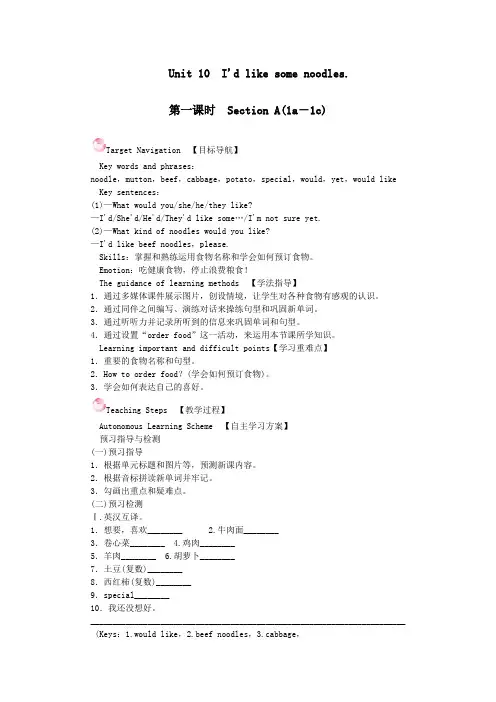
Unit 10 I'd like some noodles.第一课时Section A(1a-1c)Target Navigation 【目标导航】Key words and phrases:noodle,mutton,beef,cabbage,potato,special,would,yet,would like Key sentences:(1)—What would you/she/he/they like?—I'd/She'd/He'd/They'd like some…/I'm not sure yet.(2)—What kind of noodles would you like?—I'd like beef noodles,please.Skills:掌握和熟练运用食物名称和学会如何预订食物。
Emotion:吃健康食物,停止浪费粮食!The guidance of learning methods 【学法指导】1.通过多媒体课件展示图片,创设情境,让学生对各种食物有感观的认识。
2.通过同伴之间编写、演练对话来操练句型和巩固新单词。
3.通过听听力并记录所听到的信息来巩固单词和句型。
4.通过设置“order food”这一活动,来运用本节课所学知识。
Learning important and difficult points【学习重难点】1.重要的食物名称和句型。
2.How to order food?(学会如何预订食物)。
3.学会如何表达自己的喜好。
Teaching Steps 【教学过程】Autonomous Learning Scheme 【自主学习方案】预习指导与检测(一)预习指导1.根据单元标题和图片等,预测新课内容。
2.根据音标拼读新单词并牢记。
3.勾画出重点和疑难点。
(二)预习检测Ⅰ.英汉互译。
1.想要,喜欢________ 2.牛肉面________3.卷心菜________ 4.鸡肉________5.羊肉________ 6.胡萝卜________7.土豆(复数)________8.西红柿(复数)________9.special________10.我还没想好。
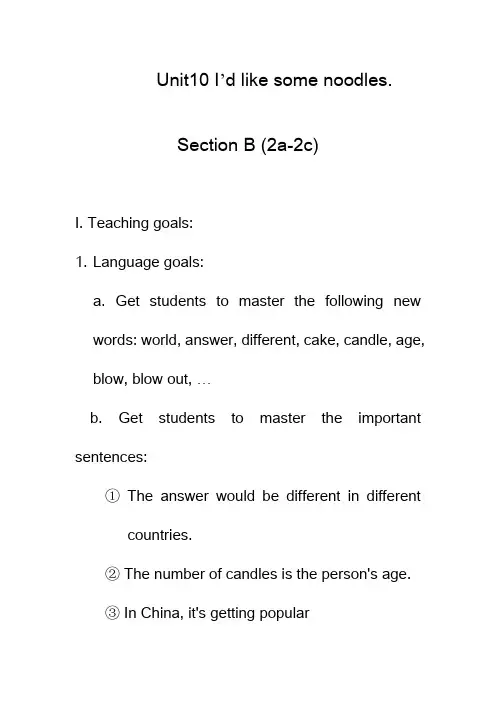
Unit10 I’d like some noodles.Section B (2a-2c)I. Teaching goals:nguage goals:a. Get students to master the following newwords: world, answer, different, cake, candle, age, blow, blow out, …b. Get students to master the important sentences:①The answer would be different in differentcountries.② The number of candles is the person's age.③ In China, it's getting popular2.Emotion goal:Get students to know the culture of birthday food in the world.II. Teaching important and difficult points:a. Get students to master the new words andimportant sentences.b. Improve students’ reading skills.III. Teaching processes:Step1. Lead inListen a birthday song and talk about “What do you do or eat on your birthday?”Step2. PresentationPresent some new words and expressions to the Ss.Students learn the new words and expressions by themselves and try to remember them.Step3.Reading1. Fast readingTrue or False2. Careful readingRead the passage and complete the chart below.3. Read the messages again. Find the answers to the questions in 2c.Step4. After readingRead the passage again and complete the passage. Step5. Outside readingRead an extracurricular passage and know the different birthday foods in different countries.IV. HomeworkBlackboard design:上官锦霞Welcome To Download !!!欢迎您的下载,资料仅供参考!。
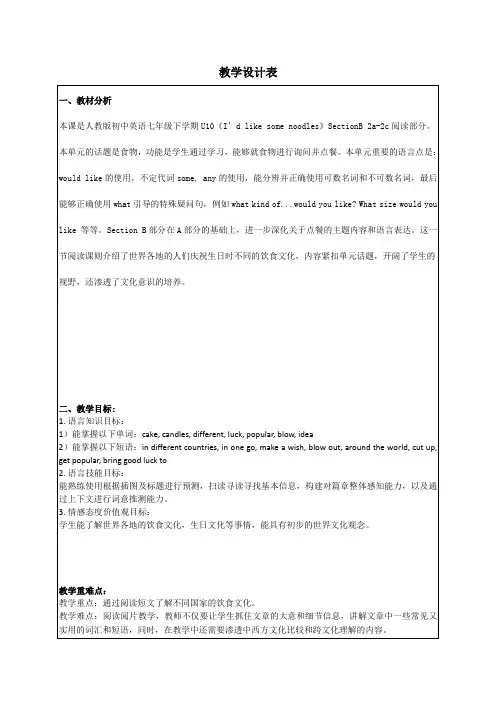
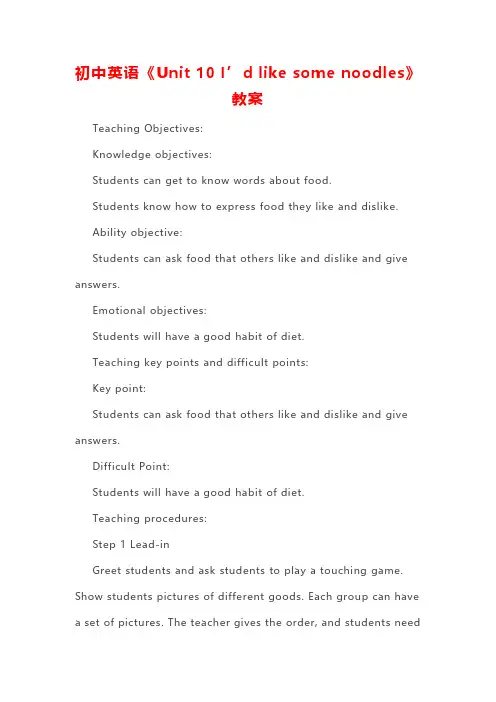
初中英语《Unit10I’d like some noodles》教案Teaching Objectives:Knowledge objectives:Students can get to know words about food.Students know how to express food they like and dislike.Ability objective:Students can ask food that others like and dislike and give answers.Emotional objectives:Students will have a good habit of diet.Teaching key points and difficult points:Key point:Students can ask food that others like and dislike and give answers.Difficult Point:Students will have a good habit of diet.Teaching procedures:Step1Lead-inGreet students and ask students to play a touching game. Show students pictures of different goods.Each group can have a set of pictures.The teacher gives the order,and students needto touch the food mentioned.See which group is fastest and correct.(Justification:Touching game can attract students’attention to the class.Students can also review words they have learned.) Step2Pre-listening1.Show students the picture in1a.Ask them to match words with pictures.2.Work in pair.Ask students to talk about the food they like and dislike.The teacher shows them dialogue pattern.(Justification:In this step,students can get closer to the the topic.By working with their partners,students can begin to talk according to their own situation so that their ability of expressing themselves can be improved.)Step3While-listening1.Listen to the tape and complete the order form.Ask students to work in group.Each group is given a set of cards with different choices for the blank in the order form.After listening to the tape,students must choose correct information and stick the card on the form.2.Listen to the tape again and check the answers.3.Listen to the tape for the third time.Ask students to read after the tape and pay attention to the stress,pronunciation, intonation.(Justification:Through three times for listening,students can get to deal with detail information in the listening material.At the same time,their speaking ability can be improved after the tape.Asking students to pay attention to the intonation which can help students understand the tone of warning.Group working can reduce difficulty in listening.)Step4Post-listeningRole play.Suppose that you go to a restaurant with your friends.Act out what will happen.Show them dialogue patterns.(Justification:In this step,students can use what they learned in the previous steps.Role play can help students get emerged in the real situation and talk in a more communicative way.) Step5Summary and homeworkSummary:Invite one student to summarize what we have learned today.Homework:Know about your parents’diet.Ask them what they like and dislike.Share the next class.Blackboard design:。
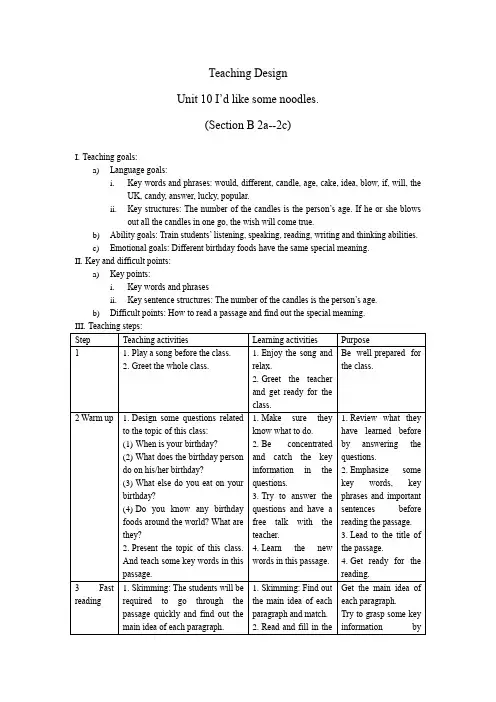
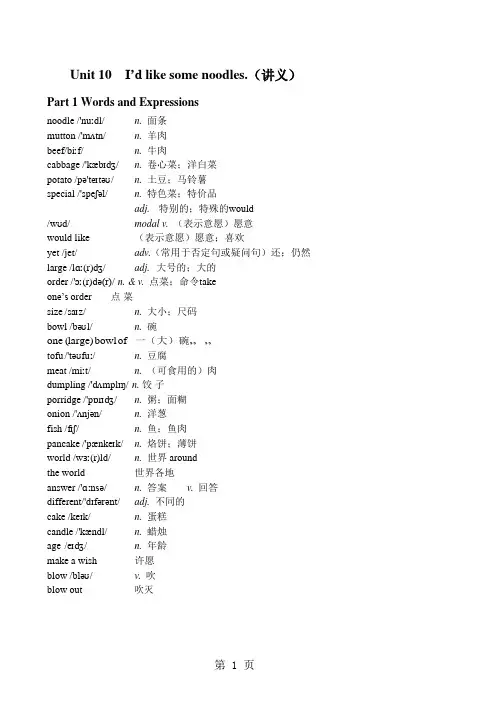
Unit 10 I’d like some noodles.(讲义)Part 1 Words and Expressionsnoodle /'nuːdl/ n. 面条mutton /'mʌtn/ n. 羊肉beef/biːf/ n. 牛肉cabbage /'kæbɪdʒ/ n. 卷心菜;洋白菜potato /pə'teɪtəʊ/ n. 土豆;马铃薯special /'speʃəl/n. 特色菜;特价品adj. 特别的;特殊的would/wʊd/ modal v. (表示意愿)愿意would like (表示意愿)愿意;喜欢yet /jet/ adv.(常用于否定句或疑问句)还;仍然large /lɑː(r)dʒ/ adj. 大号的;大的order /'ɔː(r)də(r)/n. & v. 点菜;命令takeone’s order 点菜size /saɪz/ n. 大小;尺码bowl /bəʊl/ n. 碗one (large) bowl of 一(大)碗……tofu /'təʊfuː/ n. 豆腐meat /miːt/ n. (可食用的)肉dumpling /'dʌmplɪŋ/n. 饺子porridge /'pɒrɪdʒ/ n. 粥;面糊onion /'ʌnjən/n. 洋葱fish /fɪʃ/ n. 鱼;鱼肉pancake /'pænkeɪk/ n. 烙饼;薄饼world /wɜː(r)ld/ n. 世界aroundthe world 世界各地answer /'ɑːnsə/n. 答案v. 回答different/'dɪfərənt/adj. 不同的cake /keɪk/ n. 蛋糕candle /'kændl/ n. 蜡烛age /eɪdʒ/ n. 年龄make a wish 许愿blow /bləʊ/ v. 吹blow out 吹灭if /ɪf/ conj. 如果will /wɪl/ v. 将要;会the UK /,ju: 'kei/(=the United Kingdom /ju'naɪtɪd 'kɪŋdəm/)n. 英国candy /'kændi/ n. 糖果lucky /'lʌki/ adj. 幸运的popular/'pɒpjʊlə/ adj. 受欢迎的;普遍的get popular 受欢迎;流行cut up 切碎idea /aɪ'dɪə/n. 想法;主意bring good luck to…给……带来好运specialn. 特色菜;特价品We have some great specials today.adj. 特殊的;特别的The teacher always makes every child feel special.I would like you to try this kind of food. It is very special.Bob is a special friend of mine.would likeI want a large bowl of noodles.I would like a large bowl of noodles.I want to order a cup of coffee.I would like to order a cup of coffee.would like 意为“想要;愿意”,比w ant 语气更委婉。
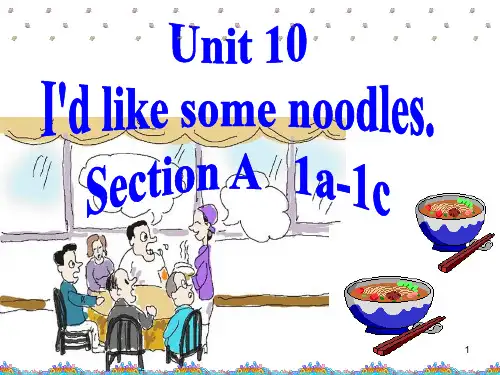
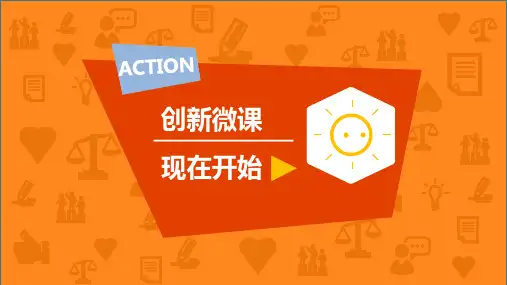
Unit 10 I’d like some noodles (Reading)一、教学内容分析本部分为SectionB的阅读部分,2a-2c的阅读部分介绍了世界各地的人们庆祝生日时不同的饮食文化,内容紧扣单元话题,开阔了学生的视野,还渗透了文化意识的培养。
本部分的教学重点是巩固学生对单元功能和语法结构的理解,通过阅读短文了解不同国家的饮食文化。
教学难点是阅读语篇教学,教师不仅要让学生抓住文章的大意细节信息,讲解文章中一些常见又实用的词汇和短语,同时,在教学中还需要渗透中西方文化比较和文化理解的内容。
二、教学目标知识目标:1)掌握以下词汇:world, answer, different, cake, candle, age, blow, blow out, if, will, UK, candy, lucky, popular, cut up idea2)掌握以下句型:① The answer would be different in different countries.② The number of candles is the person's age.③ In China, it's getting popular能力目标:通过训练,提高阅读的能力,运用不同的阅读技巧完成不同的任务。
学会篇章分析情感目标:该部分学习内容贴近学生的生活,谈论的主题涉及食物名称,世界各地的人们庆祝生日时的不同饮食文化,使学生们具有初步的世界文化观念,并引导学生学会感恩,在得到的同时要学会给予。
三、教学策略选择与设计Reading strategies四、教学重点及难点1. 教学重点:1) 阅读中出现的重点词组;2)通过进行说、读的训练,来提高学生们综合运用所学知识的能力。
2. 教学难点阅读篇章中出现的重点词组的落实;阅读策略的教学六、板书设计Unit10 I'd like some noodles.(Section B 2a-2c) make a wish different cut up ideaa birthday cake with candles answerget popular candyblow out the candles agein one go, come true if..will Different countries have different birthday foods.。
人教版新目标英语七年级Unit10 I'd like some noodles(writing 3a-3c)说课稿Hello everyone,it's a great honor to be here to present our group's lesson for all of you, first,what we are going to present today is unit 10,I' like some noodles,section B 3a-3b, the writing part. which belongs to the content of grade seven.Our presentation will include analysis of the textbook and the students, teaching key points and teaching difficult points,teaching goals as well as the teaching procedure.This part mainly focuses on the words and expressions related to food, and a sentence structure-I'd like to do…The student of grade seven are eager to know, eager to learn. They are ambitious but kind of childish, they are active but kind of innocent. there are usually more than forty students in a class. so we usually put them into four groups.The teaching key points and difficult points are somenew words and expressions, such asbeef,mutton,fishvegetable,chicken etc, and some sentence structures--I would like..., what would you like? We need to use the mmultimedia teaching system as the teaching aid. For the teaching methods,we mainly used to tasks- based method,pair work and group work.Now I want to show you our teaching goals. The ability goals are to review the conversations while eating in a restaurant, and to write ad for the noodle house. The language goals are words, expressions and sentence structures. The emotional goal is to make students have a good dream, and do what they would like to do.龚丽Hello everyone, it's my turn to share our ideas with you. First, let me introduce our leading in for you. For this part,we will show a short video -A Bite of China to the students.After this, we will make a brief explanation for the new word-bite by using a picture.At last, we will present the Chinese meaning.For the pre-writing, we want to encourage thestudents to do a brain storm- A Bite of Liupanshui. Then we are going to present pictures of delicious food here,including mutton rice noodles, beef noodles, chicken soup noodles, sour fish soup noodles, baked pot, roast fish,and sticky rice chicken.After the presentation of the food, the teacher encourages the students to answer the question-what would you like to eat?刘培卫Hello everyone, it's my turn to show our ideas with you, for this part, we want to help students to create real situations, the students will get words of food for writing. We are going to put the students into four groups, and each group get a task of cooking a kind of noodles.The students will get the words of different ingredients needed in cooking the noodles.罗贤春Hello everyone, it's my turn to share our ideas with you. For the first group's task we are going to show the necessary ingredients they need to cook the noodles, and then we will present a sentence structure-we have noodles with pepper, beef, green onion, cabbage tomatoand so on. F or t he second group, we will present the necessary ingredients needed to cook chicken noodles, and present the sentence-we have noodles with mutton, caraway, and pepper.彭春容H ello everyone, it's my turn to be here to share our ideas with you。
After this, we are going to show the third groups' ingredients that they need to cook their noodles, show the sentence- we have noodles with chicken, green onion, carrot, cabbage and potato. At last we will show the fourth group's ingredients that they need to cook the noodles and the last sentence -we have noodles with fish, cabbage, green onion and tomato.吴俊Hello everyone,now it's my turn to share our ideas with you, for this part, we are going to give all groups to do a task-to start your own noodle house. First, the students work in pairs to ask and answer the following 5 questions. After this, the teacher asked some of the students to share the ideas with other students.At last, the teacher presents the possible answers.After all of these, the students have already gottenenough words, sentence structures and basic Information for opening a noodle house.So they are ready to write an article.何紫薇Hello everyone,now it's my turn to share our ideas with you, after doing all these, we are going to show the students a sample simple ad, the basic Information used in different parts of the article, the specific usage of the conjunctions and the basic formation of the article, telling the students that it's necessary for them to use all of these to write a good article。